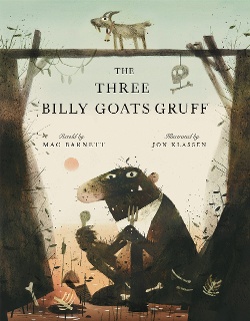What stands out to guest poster Shoshana Flax about The Three Billy Goats Gruff, illustrated by Jon Klassen and humorously retold by Mac Barnett, is the multitude of ways it uses the space available to it.
[Many Calling Caldecott posts this season will begin with the Horn Book Magazine review of the featured book, followed by the post's author's critique.]

 The Three Billy Goats Gruff
The Three Billy Goats Gruff
retold by Mac Barnett; illus. by Jon Klassen
Preschool, Primary Orchard/Scholastic 48 pp.
10/22 9781338673845 $18.99
Frequent collaborators Barnett and Klassen serve up a delectable rendition of the oft-retold folktale. The bare-bones narrative “clip clops” along with abundant humor and plenty of verbal delights, repetition, and rhyme (“Who seeks to reach the grassy ridge? / Who dares to walk across my bridge?”) as the brash, blustery bully of a troll gleefully lists all the ways he loves to eat goat. Droll, digitally compiled illustrations created with ink, watercolor, and graphite capture a proscenium view of the action above and below the bridge and depict a large, rodent-like troll who dwells in the muck of a bone-strewn riverbank. How the menacing meat-eater gets his comeuppance and the clever brothers go on to enjoy grassy glory on the other side of the bridge are the stuff of legend, and here they’re given a playful twist by these masters of the deadpan. The tale wraps up with the troll floating down the river and around a bend. “Where he ended up I really can’t say. I’ve never gone that far. There are too many mosquitoes.” Sure to be a read-aloud favorite, this engaging interpretation will sit comfortably next to classic versions by Marcia Brown, Glen Rounds, Paul Galdone, and Jerry Pinkney. LUANN TOTH
From the January/February 2023 issue of The Horn Book Magazine.
What stands out to me about The Three Billy Goats Gruff is the multitude of ways it uses the space available to it. As it opens, we see plenty of white space around the text, with the mysterious world under the bridge just creeping up from the bottom. The camera angle then shifts to let us focus on the troll for the entire verso page. After the Billy Goats Gruff enter the scene, the proscenium view Luann Toth describes above often goes across the bottom of the spread, with the height of the illustration varying. In a moment of high drama — and dramatic irony — we get the tallest across-the-spread illustration yet, as the legs of the clearly gigantic third Billy Goat Gruff appear behind the oblivious, relatively tiny troll. A few page-turns later, the focus moves in close for a wordless illustration: all we need to know is that the third billy goat’s head has successfully butted the troll (who, we see for the first time, has comically froglike legs that make him much less intimidating).
And then come the waterfalls. The troll goes over a “Big” one, a “Huge” one, and finally a “Really Enormous” one, and as they get bigger, the illustrations expand horizontally. By “The Really Enormous Waterfall,” the text has become part of the visual experience: it's squeezed into such a narrow vertical space that it cascades downward, much like a — well, you get the idea. Finally, the goats have peacefully reached their destination as the sun sets, and we fade back into mysterious minimalism.
The style and muted palette of the illustrations, “created with inks, watercolor, and graphite and compiled digitally,” will likely feel familiar to fans of Jon Klassen’s previous work — and Klassen, of course, is no stranger to the Caldecott. But none of that should matter to the committee members, who I’m sure will look closely at this title. How will it compare with the many, many serious contenders this year?
They’ll have to cross that bridge when they come to it.

ALREADY A SUBSCRIBER? LOG IN
We are currently offering this content for free. Sign up now to activate your personal profile, where you can save articles for future viewing.








Add Comment :-
Be the first reader to comment.
Comment Policy:
Comment should not be empty !!!